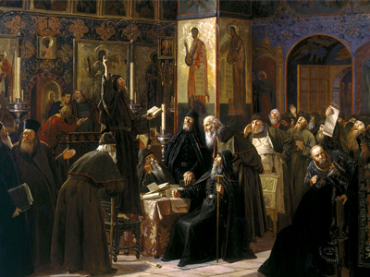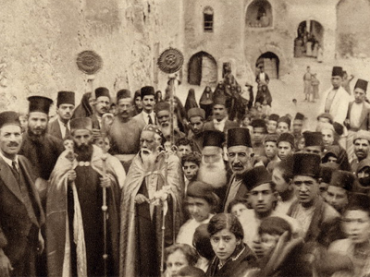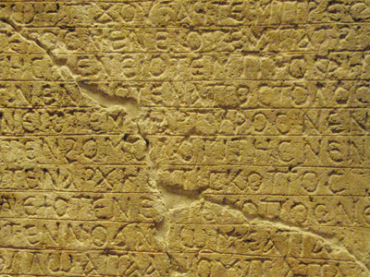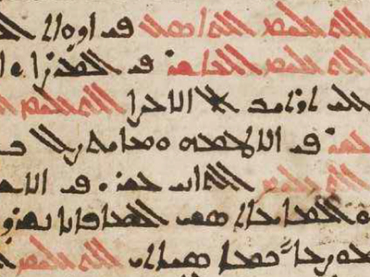Syriac and Eastern Christianity
De Timotheo I Nestorianorum Patriarcha (728-823) et Christianorum Orientalium Condicione sub Caliphi
Patriarch Timothy I and the Condition of Eastern Christians under the Abbasids
Series: Syriac Studies Library 110
ISBN: 978-1-61719-232-6
This volume focuses on the activity and structure of the Church of the East under its leader Patriarch Timothy I, whose 99 Canons are also published in translation.
$150.00
Histoire politique, religieuse et littéraire d'Édesse jusqu'à la première Croisade
By Rubens Duval
Series: Syriac Studies Library 111
ISBN: 978-1-61719-233-3
Rubens Duval, known for his Syriac grammar and editions of Syriac texts, here offers a complete historical study of Edessa up to the first Crusade. Everything from geography to language and literature to political interactions are covered.
$190.00
Ebed-Iesu Sobensis Carmina Selecta ex libro Paradisus Eden
Selections from ’Abdisho‘ bar Brikha’s Paradise of Eden
Edited and Translated by H. Gismondi
Series: Syriac Studies Library 112
ISBN: 978-1-61719-234-0
In this work, Jesuit scholar Henricus Gismondi presents ten poems from the collection of theological poetry known as the Paradise of Eden by Abdisho bar Brikha, otherwise known as Ebedjesus, (d. 1318) in Syriac and Latin.
$158.00
Festbrevier und Kirchenjahr der syrischen Jakobiten
Eine liturgiegeschichtliche Vorarbeit
Series: Syriac Studies Library 113
ISBN: 978-1-61719-235-7
This essential volume on the Syrian Orthodox liturgy (Fenquitho) by an eminent liturgist covers both the development of the liturgy itself and the structure of the church year.
$192.00
The Book of Protection, being a Collection of Charms
Now edited for the first time from Syriac mss. with translation, introduction, and notes
Edited and Translated by Hermann Gollancz
Series: Syriac Studies Library 114
ISBN: 978-1-61719-236-4
This volume is an edition, with annotated English translation, of three charm manuscripts from the seventeenth and eighteenth centuries with charms for a great number of situations.
$174.00
Ueber das Verhältniss des Textes der drei syrischen Briefe des Ignatios zu den übrigen Recensionen d
Series: Syriac Studies Library 115
ISBN: 978-1-61719-237-1
This volume is a detailed examination of the some of the letters of Ignatius available in two Greek recensions but also a Syriac translation and the relationship between these versions.
$136.00
The History of the Maronite Mission in Egypt, 1745-1927
Series: Syriac Studies Library 116
ISBN: 978-1-61719-239-5
Khoury provides a complete history of the Maronite Mission in Egypt from the mid-18th into the beginning of the 20th century, including chapters on the important figures connected with the mission and other historical events.
$169.00
Versio Syriaca Antiquissima, pars prima
Select Orations of Gregory Nazianzen in Syriac
Edited with an Introduction by P.J. Bollig
Series: Syriac Studies Library 117
ISBN: 978-1-61719-240-1
This volume contains Syriac texts of the old Syriac translation of Gregory Nazianzen’s orations edited from a Vatican manuscript. The Syriac selections in this volume total 131 parts from Gregory’s works and cover a wide variety subjects.
$168.00
Nestorius and his Teaching
A Fresh Examination of the Evidence
Series: Syriac Studies Library 118
ISBN: 978-1-61719-241-8
This still standard study on Nestorius is guided by the question: Did Nestorius mean what people have thought that he meant? Chapters cover the sources and content for our knowledge about his teaching.
$146.00
The Tradition of the Syriac Church of Antioch concerning the Primacy and the Prerogatives of St. Pet
By Cyril Behnam Benni; Translated and Annotated by Joseph Gagliardi
Series: Syriac Studies Library 119
ISBN: 978-1-61719-242-5
This volume includes both the Syriac and English of a unique work in which Cyril Behnam Benni, Archbishop of Nineveh, presents testimonies of Syriac texts on the subjects of St. Peter, the Roman Church, and the Roman Pontiffs.
$192.00
Institutiones Fundamentales Linguae Aramaicae seu Dialectorum Chaldaicae ac Syriacae
In usum juventutis academicae
Series: Syriac Studies Library 120
ISBN: 978-1-61719-243-2
This brief Syriac grammar for students, along with a prolegomena showing how Syriac fits in among other Aramaic dialects, includes the standard grammatical items. The paradigms are unique for including Jewish Aramaic forms side by side with the Syriac.
$167.00
Antiqua Ecclesiae Syro-Chaldaicae Traditio circa Petri Apostoli eiusque Successorum Romanorum Pontif
Series: Syriac Studies Library 121
ISBN: 978-1-61719-244-9
In this volume, Clemens Joseph David (1829-1890), a prominent scholar of the Syriac Catholic Church and Archbishop of Damascus, studies the subject of the primacy of Peter and his successors.
$169.00
The Principles of Syriac Grammar
Translated and Abridged from the Work of Dr. Hoffmann
Series: Syriac Studies Library 122
ISBN: 978-1-61719-245-6
Cowper, having reasoned that English students of Syriac deserve an affordable and complete, yet not too cumbersome and detailed, guide to the language, here offers an abridged and edited English version of Hoffmann’s grammar, originally published in Latin in 1827.
$135.00
Des Metropolitan Elias von Nisibis Buch vom Beweis der Wahrheit des Glaubens
Translated and Annotated by L. Horst
Series: Syriac Studies Library 123
ISBN: 978-1-61719-246-3
This work presents in German translation Eliya (or Elias) of Nisibis’ Book of the Proof of the Correct Faith, a polemical work with chapters against Muslims, Jews, Melkites, and Syrian Orthodox Christians.
$161.00
Die Canones Jacob's von Edessa
Übersetzt und erläutert
Translated and Annotated by C. Kayser
Series: Syriac Studies Library 124
ISBN: 978-1-61719-247-0
Kayser here offers the Syriac text and German translation of a set of answers given by the famous Jacob of Edessa to questions by the priest Addai.
$174.00
De Sancta Nicaena Synodo
Syrische Texte des Maruta von Maipherkat
Translated and Annotated by Oscar Braun
Series: Syriac Studies Library 125
ISBN: 978-1-61719-248-7
The work here translated from Syriac contains canons and a series of other texts related to the Council of Nicea that have a connection to Marutha of Maipherqat, known for convening the Synod of Seleucia-Ctesiphon in 410.
$157.00
An Ancient Syriac Translation of the Kur’an exhibiting New Verses and Variants
Series: Analecta Gorgiana 639
ISBN: 978-1-61719-588-4
The focus of this study is the final part of Dionysius bar Salibi’s polemical work against the Muslims, which contains a number of quotations from the Qur’an in Syriac translation.
$46.00
The Early Spread of Christianity in Central Asia and the Far East
A New Document
Series: Analecta Gorgiana 640
ISBN: 978-1-61719-589-1
The main goal of this study is to present data from Syriac and Christian Arabic writers, and some other sources, dealing with missionary activity and the expansion of Christianity into east Asia.
$49.00
The Early Spread of Christianity in India
Series: Analecta Gorgiana 641
ISBN: 978-1-61719-590-7
Mingana here looks at the early history of Christianity in India, with references to most (if not all) of the passages in Syriac and Christian Arabic literature, as well as other documentary evidence, pertaining to the subject.
$50.00
Ordo Missae Syro-Chaldaeo-Malabaricae cum Translatione Latina
The Malabar Mass in Syriac and Latin
Edited and Translated by Aloysius Pareparambil
Series: Analecta Gorgiana 642
ISBN: 978-1-61719-591-4
This volume, with a short preface, contains the Mass for the Syro-Chaldean Malabar Church in fully vocalized east Syriac script with a parallel Latin translation.
$47.00
Untersuchungen zur Syntax des Afraates
I. Die Relativpartikel und der Relativsatz
Series: Analecta Gorgiana 646
ISBN: 978-1-61719-595-2
This grammatical study focuses on how the relative particle is used in the Demonstrations of fourth century Syriac author Aphrahat. A great number of examples from Aphrahat’s writings are included in both Syriac and in German translation.
$43.00
The Scholia of Barhebraeus on the Gospel of Matthew
Gregorii Abulfarag Bar Ebhraya in Evangelium Matthaei Scholia
Edited by J. Spanuth
Series: Analecta Gorgiana 651
ISBN: 978-1-61719-600-3
This volume contains the Syriac text of Barhebraeus’ critical and doctrinal commentary on the Gospel of Matthew from his work known as the Storehouse of Mysteries.
$47.00
Catalogue of Psalms Recited in the Prayers
The Syrian Diocese of Mosul
Introduction by Cyrillus Behnam Benni
Series: Analecta Gorgiana 655
ISBN: 978-1-61719-604-1
This short liturgical guidebook lists the proper Psalms to be read for the daily prayers throughout the year in the Syrian diocese of Mosul.
$40.00
The School of Nisibis
Its Origin, Statutes, and Celebrated Personages
By Addai Scher
Series: Analecta Gorgiana 656
ISBN: 978-1-61719-605-8
This brief but important work provides readers with a concise overview of the School of Nisibis, the east Syriac study center, including the famous teachers and students associated with it and its functional arrangement.
$46.00
Hymne de S. Ephrem Docteur de l’Église sur la Nativité de n. Seigneur
Edited and Translated by Ignatius Ephrem II Rahmani
Series: Analecta Gorgiana 657
ISBN: 978-1-61719-606-5
This slim volume contains the Syriac text with facing French translation (modestly annotated) of one of Ephrem’s hymns on the Nativity.
$37.00
Filter by
Filter by price
Filter by manufacturer































